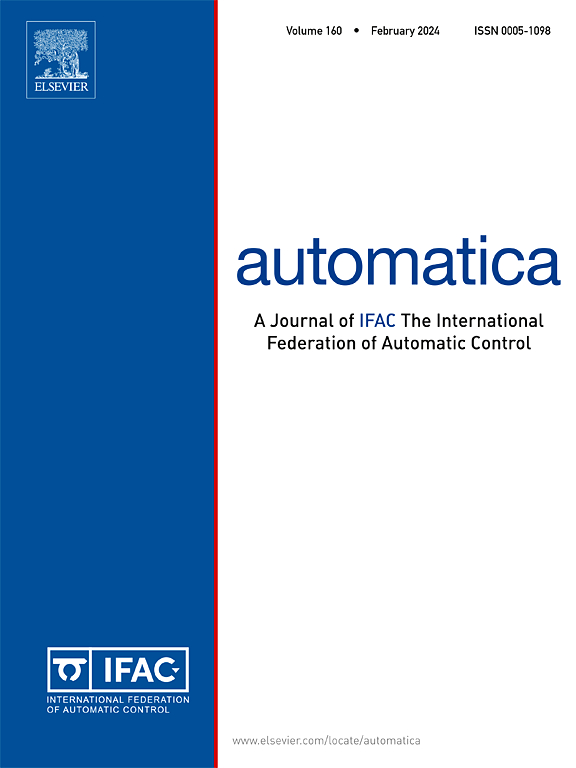Robust optimal density control of robotic swarms
IF 5.9
2区 计算机科学
Q1 AUTOMATION & CONTROL SYSTEMS
引用次数: 0
Abstract
In this paper we propose a computationally efficient, robust density control strategy for the mean-field model of a robotic swarm. We formulate a static optimal control problem (OCP) that computes a robot velocity field which drives the swarm to a target equilibrium density, and we prove the stability of the controlled system in the presence of transient perturbations and uncertainties in the initial conditions. The density dynamics are described by a linear elliptic advection–diffusion equation in which the control enters bilinearly into the advection term. The well-posedness of the state problem is ensured by an integral constraint. We prove the existence of optimal controls by embedding the state constraint into the weak formulation of the state dynamics. The resulting control field is space-dependent and does not require any communication between robots or costly density estimation algorithms. Based on the properties of the primal and dual systems, we first propose a method to accommodate the state constraint. Exploiting the properties of the state dynamics and associated controls, we then construct a modified dynamic OCP to speed up the convergence to the target equilibrium density of the associated static problem. We show that the finite-element discretization of the static and dynamic OCPs inherits the structure and several useful properties of their infinite-dimensional formulations. Finally, we demonstrate the effectiveness of our control approach through numerical simulations of scenarios with obstacles and an external velocity field.
机器人群体的鲁棒最优密度控制
本文针对机器人群的平均场模型提出了一种计算效率高、鲁棒的密度控制策略。提出了一个静态最优控制问题(OCP),该问题计算了一个机器人速度场,使群体达到目标平衡密度,并证明了在初始条件下存在瞬态扰动和不确定性时被控系统的稳定性。密度动力学用线性椭圆平流扩散方程来描述,其中控制双线性进入平流项。通过一个积分约束来保证状态问题的适定性。我们通过将状态约束嵌入到状态动力学的弱公式中来证明最优控制的存在性。由此产生的控制场是空间依赖的,不需要机器人之间的任何通信或昂贵的密度估计算法。基于原系统和对偶系统的性质,我们首先提出了一种适应状态约束的方法。利用状态动力学和相关控制的特性,构造了一个改进的动态OCP,加快了相关静态问题收敛到目标平衡密度的速度。我们证明了静态和动态ocp的有限元离散化继承了其无限维公式的结构和几个有用的性质。最后,我们通过具有障碍物和外部速度场的场景的数值模拟证明了我们的控制方法的有效性。
本文章由计算机程序翻译,如有差异,请以英文原文为准。
求助全文
约1分钟内获得全文
求助全文
来源期刊

Automatica
工程技术-工程:电子与电气
CiteScore
10.70
自引率
7.80%
发文量
617
审稿时长
5 months
期刊介绍:
Automatica is a leading archival publication in the field of systems and control. The field encompasses today a broad set of areas and topics, and is thriving not only within itself but also in terms of its impact on other fields, such as communications, computers, biology, energy and economics. Since its inception in 1963, Automatica has kept abreast with the evolution of the field over the years, and has emerged as a leading publication driving the trends in the field.
After being founded in 1963, Automatica became a journal of the International Federation of Automatic Control (IFAC) in 1969. It features a characteristic blend of theoretical and applied papers of archival, lasting value, reporting cutting edge research results by authors across the globe. It features articles in distinct categories, including regular, brief and survey papers, technical communiqués, correspondence items, as well as reviews on published books of interest to the readership. It occasionally publishes special issues on emerging new topics or established mature topics of interest to a broad audience.
Automatica solicits original high-quality contributions in all the categories listed above, and in all areas of systems and control interpreted in a broad sense and evolving constantly. They may be submitted directly to a subject editor or to the Editor-in-Chief if not sure about the subject area. Editorial procedures in place assure careful, fair, and prompt handling of all submitted articles. Accepted papers appear in the journal in the shortest time feasible given production time constraints.
 求助内容:
求助内容: 应助结果提醒方式:
应助结果提醒方式:


